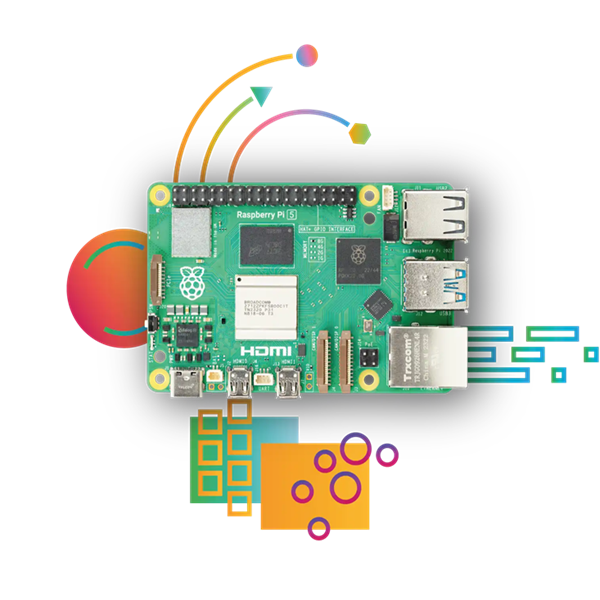Raspberry Pi 5 is the latest addition to the Raspberry Pi lineup, bringing significant enhancements in performance, connectivity, and user experience. Here are some key details:

- Dimensions: It maintains the traditional Raspberry Pi form factor, measuring 85.6mm x 56.5mm x 17mm, ensuring compatibility with a wide range of existing cases and accessories.
- Processor: The Raspberry Pi 5 features a Broadcom BCM2712 quad-core 64-bit ARM Cortex-A76 processor, clocked at 2.4GHz. This represents a considerable leap in processing power over its predecessor, the Raspberry Pi 4.
- Memory: It comes with options for 4GB, 8GB, or 16GB of LPDDR4X SDRAM, providing a range of memory options to suit various needs and budgets.
- Wireless Connectivity:
- Dual-band 802.11ac Wireless LAN (WLAN) with MIMO, supporting both 2.4GHz and 5GHz bands for fast and reliable internet access.
- Bluetooth 5.0 with BLE, offering improved power management, range, and data transfer capabilities.
- I/O Interfaces:
- 40 GPIO pins for hardware interfacing and expansion.
- Two USB 3.0 ports and two USB 2.0 ports, providing high-speed data transfer for compatible peripherals.
- Dual micro HDMI ports, capable of supporting dual 4Kp60 resolution displays.
- Gigabit Ethernet with Power-over-Ethernet (PoE) capability (with an optional PoE+ HAT).
- A PCIe 2.0 interface for high-speed peripheral connectivity, allowing for future expansion options.
- A microSD card slot for storage, now with better support for larger capacity cards.
- A CSI camera connector and a DSI display connector.
- A USB-C port for power input, supporting up to 5V/5A for improved power management.
- An audio jack for sound output.
- Storage: Uses a microSD card for the operating system and data storage, with potential support for NVMe SSDs via the PCIe interface.
- Power: Requires a 5V/5A power supply, reflecting its higher power requirements due to enhanced features.
- Price: The Raspberry Pi 5 is priced according to its memory size, with the entry-level model offering great value for performance.
- Usage:
- Education: With its advanced capabilities, it’s ideal for teaching complex computing concepts, AI, machine learning, and other advanced topics.
- DIY Projects: Suitable for sophisticated projects like media centers, gaming consoles, home automation, robotics, and IoT devices.
- Embedded Systems: Its performance and connectivity make it suitable for high-performance embedded applications.
- Development: A go-to choice for developers due to its increased performance, making it perfect for software and hardware prototyping, especially in fields like robotics, IoT, and multimedia.
Key Advantages:
- Performance: The Cortex-A76 processor provides a significant boost in processing power, enabling more demanding applications.
- Memory Options: Multiple memory options allow users to choose the model that best fits their project’s requirements.
- Improved Connectivity: Faster USB, dual HDMI, PCIe, and Gigabit Ethernet offer versatile connectivity options.
- 4K Video Support: Capable of dual 4K output at 60fps, making it suitable for multimedia applications.
- USB-C Power: The USB-C power input provides a more reliable and stable power connection.
Limitations:
- Heat: The increased performance can generate more heat, necessitating adequate cooling for intensive use.
- Cost: While still affordable, the higher-end models with more memory are more expensive than previous Raspberry Pi models.
- Power Consumption: The Raspberry Pi 5 requires more power, which might be a consideration for battery-powered projects.
The Raspberry Pi 5 represents a significant evolution in the Raspberry Pi ecosystem, offering performance that rivals or exceeds many low-end desktop computers. Its enhancements in processing power, memory options, and connectivity make it an excellent platform for a wide range of applications, from educational to professional, and it continues to be a cornerstone in the maker and tech community.
Documents
- Raspberry Pi 5 product brief
- Raspberry Pi 5 mechanical drawing
- Getting started documentation
- RP1 peripherals documentation
Compliance
Raspberry Pi 5 has undergone extensive compliance testing and meets a number of regional and international standards.
View and download relevant certificates and conformity documents.
If you require any further information regarding compliance, please contact us at compliance@raspberrypi.com.
The Adopted Trademarks HDMI®, HDMI High-Definition Multimedia Interface, and the HDMI Logo are trademarks or registered trademarks of HDMI Licensing Administrator, Inc. in the United States and other countries.
